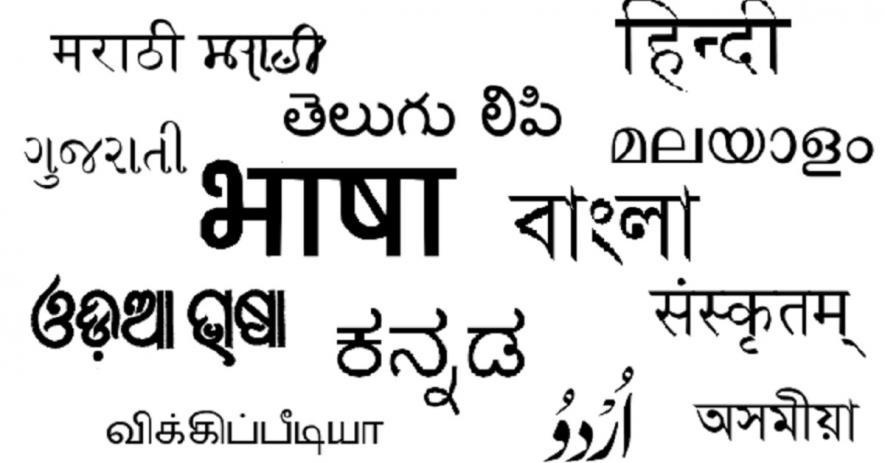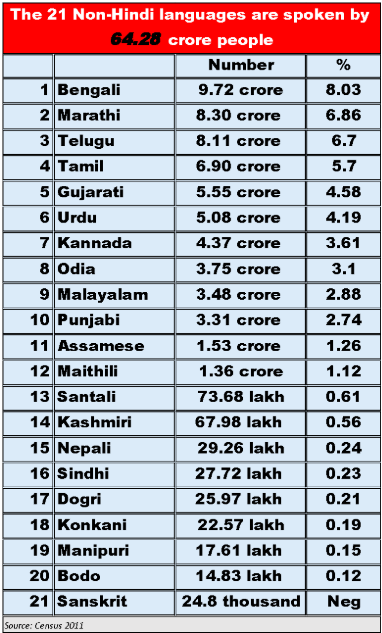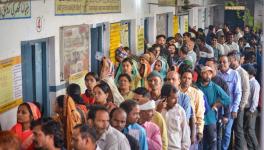About 68 Crore People of India Don’t Speak Hindi, Mr Shah

On Hindi Divas (‘Hindi Day’), home minister Amit Shah took to Twitter to repeat what the Sangh Parivar has been covertly or overtly peddling for many years: that Hindi language should be adopted by all Indians, it is the source of unity and identity of India. He further added that in any case it is the most spoken language in India, with 44% people already speaking it.
Typically, Shah failed to see the pitfall of the numbers he was quoting. If 44% speak Hindi then obviously the remaining 56% do not speak Hindi. Or, to be more precise, their mother tongue and their most used (primary) language is not Hindi. That being the case, how can Hindi become the thread of unity or the identity of India?
It does not matter to Shah that a staggering number of people – about 68 crore – do not speak Hindi in India. This includes 64.28 crore people who speak one of the 21 other Scheduled languages (i.e. those included in the Eighth Schedule of the Constitution, along with Hindi) and another 3.98 crore people who speak 99 other non-Scheduled languages, as per Census 2011.

There is already a storm of protest from Karnataka, Tamil Nadu, West Bengal, Telangana and other states on Shah’s statement.
As the table below shows, the 21 non-Hindi languages in the Eighth Schedule of the Constitution are spoken by over 64 crore people, with many language speakers running into several crores each. Are they expected to adopt Hindi as their spoken language, and learn Hindi compulsorily – or even Sanskrit?

Some may wonder if this is a storm in a tea-cup? Perhaps Shah is just saying that Hindi should be developed as a language that connects everybody?
But Shah’s antecedents do not allow such a charitable conclusion. Only a few months earlier, the draft New Education Policy had recommended that Hindi should be learnt by all students, causing another round of protests from various non-Hindi speaking peoples.
But the history of seeing and believing that Hindi could be the language of unity goes much further back. In fact, it is embedded in the Rashtriya Swayamsevak Sangh’s (RSS) vision of a united Hindu Nation with one religion, one culture, and one language. In this conception, Sanskrit is seen as the mother of all languages. See, for example, what the Akhil Bharatiya Pratinidhi Sabha of the RSS had to say back in 1958:
The R.S.S. has looked upon all languages of Bharat as National. ……They have been equally sustained by Sanskrit- the Rashtra Bhasha par excellence. If now some difference has come to forefront it is due to a policy of deliberate neglect of Sanskrit that has been consistently followed. The Sabha considers the present situation detrimental to national unity and feels that the language policy be unequivocally restated and firmly implemented, thus dispelling all apprehensions of the people. Hindi, for some time past, has evolved as the common language of inter-provincial communication. It should be used as such for all official purposes. The regional languages should be used in their respective areas. As development of all languages is possible only on the basis of Sanskrit, instruction in it should be compulsorily imparted.
[p.11-12 RSS Resolves 1950-2007; Suruchi Prakashan, New Delhi; 2007] (emphasis added)
So, there you have it. They believe that Sanskrit is the origin of all Indian languages and that development of all languages is possible only by compulsorily teaching Sanskrit to everybody. It is not possible here to go into the reasons why and how Sanskrit became the language of ruling elite over history and hundreds of languages and dialects arose, adopted and spoken by millions over the course of centuries. But even linguistically, the conception is false: Indian languages today belong to various diverse linguistic groups, including 17 Dravidian languages, 14 Austro-Asiatic languages, 66 Tibeto-Burmese languages and one Semito-Hamitic language, besides those of the Indo-Aryan group linked to Sanskrit.
Behind Shah’s statement, and behind the Sangh Parivar’s vision lies a belief that uniting the Hindu Nation is a difficult task given the plurality of languages, cultures, religions, customs and beliefs and, of course, castes, of the people of India. It can only be done by some kind of unifying force, which the RSS has been searching for ever since it was founded.
That is why it keeps coming back to one language (Hindi/Sanskrit), one religion (Hindutva), and currently similar other products of this hegemonic vision like one flag, one law, etc. That’s why Article 370 and 35A had to go. That’s why Uniform Civil Code needs to be forced upon everybody. In fact, just after Independence, the RSS weekly, Organiser, had even rejected the Constitution and called for Manu Smriti to be adopted as India’s Constitution!
So, what Amit Shah is recommending is just the thin end of the wedge. It is part of a larger dream of regimentalising Indian society and destroying its cherished diversity. He may only suggest or recommend Hindi as a ‘unifying’ language, or the signifier of Indian identity today. What he really wants is a Hindu Nation defined by brahminical rules based on Manu Smriti, where religious minorities and other language speakers have no place.
Get the latest reports & analysis with people's perspective on Protests, movements & deep analytical videos, discussions of the current affairs in your Telegram app. Subscribe to NewsClick's Telegram channel & get Real-Time updates on stories, as they get published on our website.
























